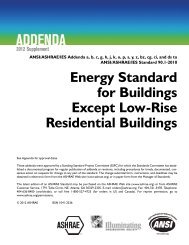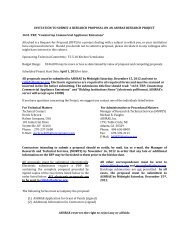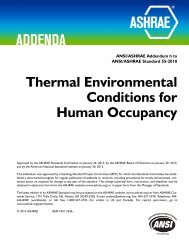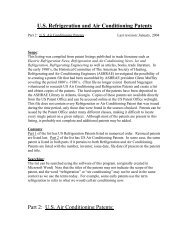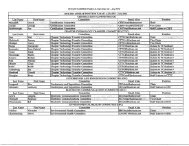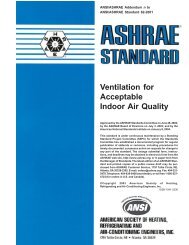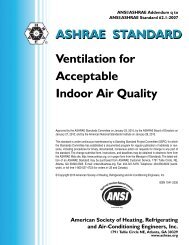ANSI/ASHRAE Standard 62.1-2007 ASHRAE STANDARD Ventilation
ANSI/ASHRAE Standard 62.1-2007 ASHRAE STANDARD Ventilation
ANSI/ASHRAE Standard 62.1-2007 ASHRAE STANDARD Ventilation
You also want an ePaper? Increase the reach of your titles
YUMPU automatically turns print PDFs into web optimized ePapers that Google loves.
Exceptions:<br />
1. If the number of people expected to occupy the ventilation<br />
zone fluctuates, zone population equal to the average<br />
number of people shall be permitted, provided such average<br />
is determined in accordance with Section 6.2.6.2.<br />
2. If the largest or average number of people expected to<br />
occupy the ventilation zone cannot be established for a<br />
specific design, an estimated value for zone population<br />
shall be permitted, provided such value is the product of the<br />
net occupiable area of the ventilation zone and the default<br />
occupant density listed in Table 6-1.<br />
Note: Revise Sections 6.2.2.2 and 6.2.2.3 as follows:<br />
6.2.2.2 Zone Air Distribution Effectiveness. The zone<br />
air distribution effectiveness (E z ) shall be no greater than the<br />
default value determined using Table 6-2.<br />
Note: For some configurations, the default value depends<br />
upon space and supply air temperature.<br />
6.2.2.3 Zone Outdoor Airflow. The design zone outdoor<br />
airflow (V oz ), i.e., the outdoor airflow rate that must be<br />
provided to the ventilation zone by the supply air distribution<br />
system, shall be determined in accordance with Equation 6-2.<br />
V oz = V bz/E z<br />
(6-2)<br />
Note: Revise Sections 6.2.3 and 6.2.4 as follows:<br />
6.2.3 Single-Zone Systems. When For ventilation systems<br />
wherein one or more air handlers supplyies a mixture of<br />
outdoor air and recirculated air to only one ventilation zone,<br />
the outdoor air intake flow (V ot ) shall be determined in accordance<br />
with Equation 6-3.<br />
Vot = Voz (6-3)<br />
6.2.4 100% Outdoor Air Systems. When For ventilation<br />
systems wherein one or more air handlers supplyies only outdoor<br />
air to one or more ventilation zones, the outdoor air<br />
intake flow (Vot ) shall be determined in accordance with<br />
Equation 6-4.<br />
V ot = ∑ all zonesV oz<br />
Note: Revise Section 6.2.5 as follows:<br />
(6-4)<br />
6.2.5 Multiple-Zone Recirculating Systems. When For<br />
ventilation systems wherein one or more air handlers supplyies<br />
a mixture of outdoor air and recirculated return air to<br />
more than one ventilation zone, the outdoor air intake flow<br />
(V ot ) shall be determined in accordance with Sections 6.2.5.1<br />
through 6.2.5.4.<br />
6.2.5.1 Primary Outdoor Air Fraction. When Table 6-<br />
3 is used to determine system ventilation efficiency, the zone<br />
Primary outdoor air fraction (Z pz ) shall be determined for<br />
ventilation zones in accordance with Equation 6-5.<br />
Zpz = Voz/Vpz (6-5)<br />
where Vpz is the zone primary airflow, i.e., the primary airflow<br />
rate to the ventilation zone from the air handler, including<br />
outdoor air and recirculated return air.<br />
Note: For VAV systems, V pz is the minimum expected<br />
primary airflow for design purposes. For VAV-system design<br />
purposes, V pz is the lowest zone primary airflow value<br />
expected at the design condition analyzed.<br />
Note: In some cases it is acceptable to determine these<br />
parameters for only selected zones as outlined in Normative<br />
Appendix A.<br />
6.2.5.2 System <strong>Ventilation</strong> Efficiency. The system ventilation<br />
efficiency (E v ) shall be determined using in accordance<br />
with Table 6-3 or Normative Appendix A.<br />
6.2.5.3 Uncorrected Outdoor Air Intake. The design<br />
uncorrected outdoor air intake (V ou ) flow shall be determined<br />
in accordance with Equation 6-6.<br />
V ou = D∑ all zones (R p · P z ) + ∑ all zones (R a · A z ) (6-6)<br />
6.2.5.3.1 Occupant Diversity. The occupant diversity,<br />
D, may be used to ratio (D) shall be determined in accordance<br />
with Equation 6-7 to account for variations in<br />
occupancy population within the ventilation zones served by<br />
the system. The occupancy diversity is defined as<br />
D=Ps/∑all zones Pz (6-7)<br />
where the system population (Ps ) is the total population in the<br />
area served by the system.<br />
Exception: Alternative methods may be used to account<br />
for population occupant diversity when calculating Vou shall<br />
be permitted, provided that the resulting Vou value is no less<br />
than that determined by using Equation 6-6.<br />
Note: The uncorrected outdoor air intake (V ou ) is<br />
adjusted for occupant diversity but uncorrected it is not<br />
corrected for system ventilation efficiency.<br />
6.2.5.3.2 Design System Population. Design system<br />
population (P s ) shall equal the largest (peak) number of people<br />
expected to occupy all ventilation zones served by the ventilation<br />
system during typical usage.<br />
Note: Design system population is always equal to or less<br />
than the sum of design zone population for all zones in the area<br />
served by the system, since all zones may or may not be simultaneously<br />
occupied at design population.<br />
6.2.5.4 Outdoor Air Intake. The design outdoor air<br />
intake flow (V ot ) shall be determined in accordance with<br />
Equation 6-8.<br />
V ot = V ou /E v<br />
Note: Revise Section 6.2.6 as follows:<br />
<strong>ANSI</strong>/<strong>ASHRAE</strong> Addenda g, r, and t to <strong>ANSI</strong>/<strong>ASHRAE</strong> <strong>Standard</strong> <strong>62.1</strong>-<strong>2007</strong> 5<br />
(6-8)<br />
6.2.6 Design for Varying Operating Conditions.<br />
6.2.6.1 Variable Load Conditions. <strong>Ventilation</strong> systems<br />
shall be designed to be capable of providing no less than the<br />
required minimum ventilation rates required in the breathing<br />
zone whenever the zones served by the system are occupied,<br />
including all full- and part-load conditions.



